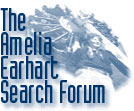
prove that Earhart was a spy?
The Morgenthau TranscriptNumerous authors have used a transcript of one side of a 1938 telelphone conversation between Secretary of the Treasury Henry Morgenthau and Eleanor Roosevelt’s personal secretary Malvina “Tommy” Thompson as evidence that Amelia Earthart had been covertly working for the U.S. Government.
The transcript is available from:
FDR Library
259 Albany Post Rd
Hyde Park, NY 12538The document contains a total of 24 pages but almost all of the references to the phone call are on one page. The original purpose of the transcript was to record the details of a Treasury Department staff meeting which took place on May 13, 1938, concerning the WPA, relief, commodities, etc. The secretary transcribed everything that was said, including Morgenthau’s side of the phone call that interrupted the meeting. What he said can easily be misconstrued to imply that a terrible secret was being kept.
H. M. Jr = Henry Morgenthau Jr.
Chauncey= ?
Gibbons= ?H.M. Jr.:(on White House phone)
Oh, hello.- Oh, thanks. Hello, Tommy (Malvina Scheider). How are you? This letter that Mrs. Roosevelt wrote me about trying to get the report on Amelia Earhart. Now, I’ve been given a verbal report. If we’re going to release this, it’s just going to smear the whole reputation of Amelia Earhart, and my ..... Yes, but I mean if we give it to this one man we’ve got to make it public; we can’t let one man see it. And if we ever release the report of the Itasca on Amelia Earhart, any reputation she’s got is gone, because- and I’d like to- I’d really like to return this to you.(continuing) Now, I know what the Navy did, I know what the Itasca did, and I know how Amelia Earhart absolutely disregarded all orders, and if we ever release this thing, goodbye Amelia Earhart’s reputation. Now, really– because if we give the access to one, we have to give it to all. And my advice is that – and if the President ever heard that somebody questioned that the Navy hadn’t made the proper search , after what those boys went through – I think they searched, as I remember it, 50,000 square miles, and every one of those planes was out, and the boys just burnt themselves out physically and every other way searching for her. And if – I mean I think he’d get terribly angry if somebody – because they just went the limit, and so did the Coast Guard. And we have the report of all those wireless messages and everything else, what that woman – happened to her the last few minutes. I hope I’ve just got to never make it public, I mean.–O.K. – Well, still if she wants it, I’ll tell her – I mean what happened. It isn’t a very nice story. –Well, yes. There isn’t anything additional to something like that. You think up a good one. – Thank you.
(conversation ends)(to Chauncey )
Just send it back.Chauncey:
Sure.H.M.Jr:
I mean we tried - people want us to search again those islands, after what we have gone through. You [meaning Gibbons] know the story, don’t you?Gibbons:
We have evidence that the thing is all over, sure. Terrible. It would be awful to make it public.(end)
The Morgenthau Transcript is a classic example of information that must be reviewed in its correct historical context to be understood.
In those days, the Coast Guard was part of the Treasury Department so Morgenthau was technically the head of the Coast Guard. At the end of the unsuccessful search for Earhart, Commander Warner K. Thompson, the captain of the Itasca, wrote up a long report entitled “Radio Transcripts Earhart Flight” which reproduced all of the radio traffic pertaining to Earhart’s flight, disappearance and the search, interspersed with Thompson’s narrative and commentary. The report is dated 19 July 1937. In accordance with Coast Guard regulations prohibiting the release of private messages (many of the radio messages were non-government) the report was classified and not made public. That was convenient for the Coast Guard from a public relations standpoint because Thompson’s report (not officially declassified until 23 September 1985) thoroughly trashes Amelia Earhart and lays the blame for the flight’s disappearance entirely upon her as an incompetent, willfully negligent, and ultimately “frantic” pilot. Not surprisingly, Thompson fails to mention the numerous errors made by the Coast Guard. He also altered some of the messages received from Earhart – when compared to the original log – so as to support his own theory and justify his own actions. Of course, nobody knew this at the time. What Morgenthau had in his hands was an indictment of an American hero.
Meanwhile, Earhart’s friend and technical advisor Paul Mantz was not at all convinced that a thorough search had been carried out of the most likely place for the flight to have gone down – the islands of the Phoenix Group. At the time of the search, he and Putnam had both publicly expressed their opinion that the plane was probably on an uninhabited island or reef. Mantz had seen Thompson’s report at the San Francisco Coast Guard headquarters immediately after the search but had not taken any notes. On April 26, 1938, knowing that AE and the First Lady had been friends, Mantz sent a letter to Eleanor asking if she could intercede with the Treasury Dept. to get him a copy of the report. On May 10, 1938 Mrs. Roosevelt wrote a note to Morgenthau saying
“...Now comes this letter. I don’t know if you can send the man these records, but, in any case, I am sending you the letter and let me know whatever your decision may be. Affectionately, E.R.”
Hence the follow-up call on May 13, 1938 by Eleanor’s personal secretary. Now read the transcript again. It makes perfect sense. The reference to Earhart disregarding orders is quite indicative of the basic problem AE had with Thompson. She considered the Coast Guard to be there to help her and, in typical Amelia style, she told them what she wanted them to do. Thompson was not about to take instructions from a girl and, whether by negligence or design, largely ignored the schedules and protocols Earhart had specified.
The true significance (or rather insignificance) of the Morgenthau transcript was fully exposed as early as 1987 in Carol Osborne’s book Amelia My Courageous Sister. That has not prevented conspiracy authors from peddling it as something it is not.
